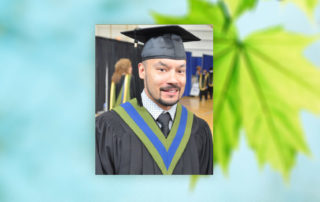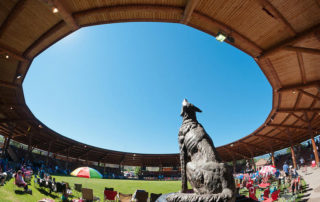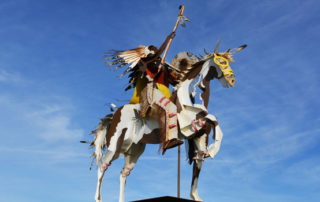-
FIRST NATIONS: SUCCESS STORIES
Tulo student profile: Jesse James, class of 2017 valedictorian Shxw’ow’hamel First Nation tax administrator
Shxw’ow’hamel First Nation’s tax administrator Jesse James was in the 2015/2016 cohort for the Certificate in First Nation Tax Administration and graduated from the program earlier this month. Three years ago, Jesse was hired by Shxw’ow’hamel as the band administrator and as the organization transitioned, he also began serving as the tax administrator. Jesse is a member of Peguis First Nation in Manitoba and has lived in BC for most of his life. Jesse was chosen by his fellow classmates as valedictorian for their cohort and delivered a speech at Tulo’s graduation dinner.
Recently Clearing the Path had the opportunity to sit down with Jesse to learn more about his experience as a tax administrator and as a student at the Tulo Centre of Indigenous Economics.
How did you first learn about the Tulo Centre and its programs?
The program description came across my desk and really interested me. When I started at Shxw’ow’hamel, we were transitioning from taxing using section 83 by-laws to taxation under the FMA. At the time, I didn’t fully understand how the tax system works or why we did things a certain way, so I jumped at the opportunity to strengthen my knowledge in that area. It worked out great because all the course material I was working on, had just completed, or was preparing to do was all falling in-line with how our transition to the FMA was progressing at Shxw’ow’hamel.
How does your experience at Tulo relate to your work at Shxw’ow’hamel?
Understanding how the laws are made, and understanding the benefits of a budget-based tax system as opposed to using reference jurisdiction was invaluable. With a budget-based system, you have to actually think about the services you will be providing ahead of time rather than figuring out expenditures after the revenues start coming in. I learned more about how to think more like a government, and it was definitely helpful to be able to ask questions of the instructors who have an incredible depth of experience and expertise.
Through the courses, I began to see how taxes can be used to benefit, support and fund initiatives the community wants. You’re creating own-source revenue and your own laws to expend funds in ways that best serve your community. It allows the community to decide how they want to spend their money and where they want to focus their priorities. Just by having that, it provides a stronger sense of community and inclusiveness. At Shxw’ow’hamel, there’s a really good sense of community so having this system in place builds on that.
You are currently working toward earning a Certificate in First Nation Applied Economics. What made you want to pursue another certificate through the Tulo Centre?
The quality of instruction is great and I like the way the curriculum is presented. Tulo’s cohort model is community-minded and that seems to work well. You get a lot from the instructor but you also get a lot from the students in the class too. Everyone shares best practices and the lessons learned, both good and bad. When we can bring that knowledge back home, that makes all of our communities better.
There were students in our class from all areas of Canada, and you can really see the similarities even though we’re separated by provinces and legislation. The issues we face and the successes we have are so similar and to be able to rely on a whole group going through the same process, doing assignments and sending out an email or picking up the phone, it really helps to have that initial support. You want to see each other do well, so you’re going to reach out and give the support, offer and in some cases, seek support. It really works.
The Tulo programs showed me there’s a lot of different ways you can create own source revenue through development cost charges or having small developments. Currently Shxw’ow’hamel doesn’t have any residential leaseholds but if we did, we’d have to set that up in advance and it’s nice to have the theory behind it. By immediately applying the theoretical knowledge we’ve learned, I’ve been able to participate in some conversations with my fellow classmates on opportunities and issues they’re going through in their communities – it is so helpful in expanding my own understanding.
Shxw’ow’hamel is a proponent of two key FNTC initiatives: the Aboriginal Resource Tax and the Indigenous Land Title Initiative. Why does Shxw’ow’hamel support these initiatives?
We’re definitely interested in seeing both initiatives go forward. With the ART, I understand it’s been a concept for a while now so we are trying to gain momentum within the group of proponents and hopefully for all First Nations in Canada. It’s just one other source of revenue for First Nation governments and it’s going to make our economies stronger and more flexible.
It’s critical to our success to have own source revenue to do what you want on your land or to purchase more land. With setting up a land registry system through ILTI, we need First Nations exercising their jurisdiction in either taxation or land ownership, that’s the bottom line.
We’ve got momentum now, we just need to keep pushing forward.
Tulo Student Profile: Gailene William
The Williams Lake Indian Band understands the importance of increasing source revenues as federal funding remains stagnant and even dwindles. Without additional funds, the band cannot grow or plan for the future. Own source revenue in the forms of taxation plays a vital role. In Williams Lake, Gailene William is taking on this role in addition to her job as the payroll/benefits administration clerk. Recently, we were able to sit down with Gailene and get her perspective on Tulo and Taxation.
How did you become enrolled in Tulo?
Our finance manager asked me if I was interested in taking the course at Tulo. Not really knowing what I was getting into, I dove right into the training without having any previous exposure to taxation but realized it would benefit me in my job and most of all, our community. I started in the fall of 2015, and took my final course in February 2017.
How does what you learned at the Tulo Centre help you in your work with Williams Lake Indian Band?
Many communities are beginning to realize taxation is the key to a better life. It isn’t something we should fear, but a way to create a better future. Managing taxation wisely for the nation requires education and practical training. To succeed, nations need a thorough knowledge of the ins and outs of the First Nation Fiscal Management Act and members who understand the band’s vision.
Being part of the Tulo experience has given me a broader outlook on the benefits of taxation and a properly running tax administration program and made me more confident in both the administration and education of taxation for WLIB.
What has been the most valuable aspect about the program for you so far?
Well the course work has been most valuable but thanks to Tulo a big part is that I now have contacts from other communities that I met in class who I can email or call for assistance and that’s really helped in creating my support network. Its allowed me to see what other communities are doing and learn from each other in addition to the time we spend in the class.
How does taxation fit into your community’s future?
I believe First Nation land taxation benefits a community and helps provide own source revenue – most communities financial planning is based on third-party funding agreements but when you also can add in other revenue, with no funding guidelines attached, you are able to look longer term. So in that essence, everyone benefits from it depending on how you budget your tax revenue. From opportunities for building new infrastructure to adding or enhancing programs and services that affect elders and youth, everyone benefits from tax revenue in our community. Tulo has been an excellent experience and it has also been a real challenge. “Introduction to First Nation Taxation” was the first exposure I’ve had to First Nation land taxation but attending Tulo has helped me greatly in all areas.
Also like many of our communities, at WLIB staff wear multiple hats and we also have our personal commitments to consider – for myself being a mom of three children I had a hard time leaving my kids for a week at a time for each of the eight classes. But thanks to some wonderful classmates and wonderful family who took care of my babies, I made it through each class and have made it through the end.
Community Profile: Tk’emlúps te Secwepemc
While TteS has many accomplishments, the visual crowning glory is undoubtedly the arbour. This magnificent structure seats 2,500 people and is home to one of the largest celebrations of Indigenous culture and heritage in Western Canada: the Kamloopa Pow Wow. Thousands of visitors witness the storytelling, song and dance in traditional regalia in this annual celebration. However, the pow wow holds special significance for Tk’emlúpsemc (Kamloops people). It celebrates their heritage, builds community, and teaches children traditions and values.
The first official Kamloopa Pow Wow in the arbour opened on the site in conjunction as part of the 1993 Canada Games. Canada Games athletes, dignitaries, tourists, locals, other First Nations and TteS community members joined together to celebrate the achievement. For many, it was the first public demonstration of their right to proudly celebrate their culture and heritage in a long time.
Saddle Lake Cree Nation: Clearing the path to a stronger future with property taxation
In the News: How a B.C. native band went from poverty to propserity
The National Post features the Osoyoos Indian Band, “arguabley the most business-minded First Nation in Canada” and investigates the secret to their success.
The article looks into the various ventures and strategies of the Osoyoose Indian Band, including property taxation. “The band also asserted control over the taxation of non-native companies leasing land on the reserve—taxes formerly scooped by the province. It was a small initiative, but it added $750,000 in annual revenue.”
Songhees Wellness Centre: a Community’s Dream Come True
A shining example of how First Nations are learning to prosper with tax jurisdiction.
Thirty years ago the Wellness Centre was a community dream, eight years ago a Songhees Committee started the process of making the dream a reality, and on January 22, 2014, the Songhees Nation celebrated the grand opening of their long-awaited Centre. The Songhees Nation, located on southeastern Vancouver Island near the City of Victoria, had first conceived of building a gym to house after-school and evening activities for the youth.
In 2005 the Songhees Nation and the Government of Canada settled the Rail Spur Claim, and the Songhees Council was able to set aside funds to begin the process of planning for their gym.
At that time, a community committee was formed to research and plan the facility. The committee and the Council collected the ideas with the guideline “if we could have anything we want, what would it look like?”
Songhees has a limited land base and its government was operating out of a number of different buildings. The community wanted a facility where all of the programs and services could be housed in one location. They wanted a gathering place for all community members, from children to elders, as well as the ability to offer sports training, job training and arts and culture programs.
The Community came together and was very proud of the resulting plan. It included all of the aspects they felt the community required to thrive.
Songhees applied for government funding for the facility, and received only $1m out of the $24m required to build. Songhees began to think out of the box and, not wanting to diminish the community’s vision, came up with a strategy to fund the building on their own. Songhees implemented the First Nations Goods and Services Tax (FNGST) and entered into a revenue sharing agreement with Canada. That revenue stream, along with a lease agreement, was enough to securitize a long-term loan.
During this process, Songhees was working with the First Nations Tax Commission on implementing the First Nations Fiscal Management Act (FMA). In 2008, Songhees became the first First Nation in Canada to pass taxation and assessment laws under the FMA (they initially began collecting property tax under the Indian Act in 1995). Songhees is certified by the First Nations Financial Management Board, is a borrowing member of the First Nations Finance Authority as has passed a Financial Administration Law.
The Songhees Nation and its Wellness Centre is a shining example of how First Nations are learning to prosper outside of the Indian Act and government funding. Songhees credits the success to community involvement and support from the First Nation fiscal institutions.
Songhees invites those interested in learning more about the Centre and how they completed this project to contact them: https://www.songheesnation.ca/




